D1074 | pyridate
| Toxicity | Dose | Time | Species | Model | Method | Action | Positive criterion | Reference |
|---|---|---|---|---|---|---|---|---|
| MEMBRANE POTENTIAL | 33.08±4.58 | human | qHTS-HepG2 | MMP assay | decrease | IC50 | 163 | |
| MEMBRANE POTENTIAL | 35.48 | human | HepG2 | MMP assay | decrease | IC50 | 163 | |
| MEMBRANE POTENTIAL | 50.45±8.18 | rat | hepatocytes | MMP assay | decrease | IC50 | 163 | |
| Pictogram | Signal | Statements | Precautionary Statement Codes |
|---|---|---|---|
  |
Warning |
H315: Causes skin irritation [Warning Skin corrosion/irritation] H317: May cause an allergic skin reaction [Warning Sensitization, Skin] H400: Very toxic to aquatic life [Warning Hazardous to the aquatic environment, acute hazard] H410: Very toxic to aquatic life with long lasting effects [Warning Hazardous to the aquatic environment, long-term hazard] |
P261, P264, P272, P273, P280, P302+P352, P321, P332+P313, P333+P313, P362, P363, P391, and P501; (The corresponding statement to each P-code can be found at the GHS Classification page.) |
  |
Warning |
Aggregated GHS information provided by 193 companies from 1 notifications to the ECHA C&L Inventory. Each notification may be associated with multiple companies. H315 (100%): Causes skin irritation [Warning Skin corrosion/irritation] H317 (100%): May cause an allergic skin reaction [Warning Sensitization, Skin] H400 (100%): Very toxic to aquatic life [Warning Hazardous to the aquatic environment, acute hazard] H410 (100%): Very toxic to aquatic life with long lasting effects [Warning Hazardous to the aquatic environment, long-term hazard] Information may vary between notifications depending on impurities, additives, and other factors. The percentage value in parenthesis indicates the notified classification ratio from companies that provide hazard codes. Only hazard codes with percentage values above 10% are shown. |
P261, P264, P272, P273, P280, P302+P352, P321, P332+P313, P333+P313, P362, P363, P391, and P501; (The corresponding statement to each P-code can be found at the GHS Classification page.) |
  |
Warning |
H315: Causes skin irritation [Warning Skin corrosion/irritation] H317: May cause an allergic skin reaction [Warning Sensitization, Skin] H410: Very toxic to aquatic life with long lasting effects [Warning Hazardous to the aquatic environment, long-term hazard] |
P261, P264, P272, P273, P280, P302+P352, P321, P332+P313, P333+P313, P362, P363, P391, and P501; (The corresponding statement to each P-code can be found at the GHS Classification page.) |
 |
Warning |
H302: Harmful if swallowed [Warning Acute toxicity, oral] H313: May be harmful in contact with skin [Acute toxicity, dermal] H315: Causes skin irritation [Warning Skin corrosion/irritation] H317: May cause an allergic skin reaction [Warning Sensitization, Skin] |
P261, P264, P270, P272, P280, P301+P312, P302+P352, P312, P321, P330, P332+P313, P333+P313, P362, P363, and P501; (The corresponding statement to each P-code can be found at the GHS Classification page.) |
| Organism | Test type | Route | Dose (normalized dose) | Effect | Source |
|---|---|---|---|---|---|
| rat | LD50 | oral | 1970mg/kg (1970mg/kg) | Defense des Vegetaux. Vol. 38, Pg. 310, 1984. | |
| duck | LD50 | oral | 10gm/kg (10000mg/kg) | Pesticide Manual. Vol. 9, Pg. 743, 1991. | |
| mouse | LD50 | oral | 10gm/kg (10000mg/kg) | Defense des Vegetaux. Vol. 35, Pg. 327, 1981. | |
| quail | LD50 | oral | 1500mg/kg (1500mg/kg) | Pesticide Manual. Vol. 9, Pg. 743, 1991. | |
| rabbit | LD50 | skin | 3400mg/kg (3400mg/kg) | Farm Chemicals Handbook. Vol. -, Pg. C257, 1991. | |
| bird - wild | LD50 | oral | 10gm/kg (10000mg/kg) | Pesticide Manual. Vol. 9, Pg. 743, 1991. | |
| (6-chloro-3-phenylpyridazin-4-yl) octylsulfanylformate | 512P339 | 55512-33-9 |
| BRN 0759528 | C-21304 | C18803 |
| CARBONOTHIOIC ACID, O-(6-CHLORO-3-PHENYL-4-PYRIDAZINYL) S-OCTYL ESTER | CAS-55512-33-9 | CHEBI:81971 |
| CHEMBL3186929 | CL 11344 | Carbonothioic acid, O-(6-chloro-3-phenyl-4-pyridizinyl) S-octyl ester |
| Caswell No. 716A | DB-052749 | DSSTox_CID_12639 |
| DSSTox_GSID_32639 | DSSTox_RID_79018 | DTXSID2032639 |
| EINECS 259-686-7 | EPA Pesticide Chemical Code 128834 | FT-0630683 |
| Fenpyrate | JQH131LU0A | JTZCTMAVMHRNTR-UHFFFAOYSA-N |
| LS-52224 | Lentagran | NCGC00255286-01 |
| O-(6-Chloro-3-phenyl-4-pyridazinyl) S-octyl carbonothioate | O-(6-Chloro-3-phenylpyridazin-4-yl) S-octyl thiocarbonate | O-6-chloro-3-phenylpyridazin-4-yl S-octyl carbonothioate; |
| P1 3419 | Pyridat | Pyridat, PESTANAL(R), analytical standard |
| Pyridat, analytical standard | Pyridate | Pyridate [BSI:ISO] |
| Pyron | Q1809267 | SCHEMBL53240 |
| Tough | Tox21_301247 | UNII-JQH131LU0A |
| ZINC2555391 | o-(6-Chloro-3-phenyl-4-pyridazinyl) S-octyl thiocarbonate |

